Find the cut-off frequency of this filter:
My attempt:
$$\text{H}\space_{\left(\omega\right)}=\frac{\text{R}_1+j\omega\text{L}}{\text{R}_1+\text{R}_2+j\omega\text{L}}=\frac{\text{R}_1+j\omega\text{L}}{\text{R}_1+\text{R}_2+j\omega\text{L}}\cdot\frac{\text{R}_1+\text{R}_2-j\omega\text{L}}{\text{R}_1+\text{R}_2-j\omega\text{L}}=$$ $$\frac{\text{R}_1^2+\text{R}_1\text{R}_2+\left(\omega\text{L}\right)^2+j\omega\text{L}\text{R}_2}{\left(\text{R}_1+\text{R}_2\right)^2+\left(\omega\text{L}\right)^2}$$
So when you're looking for the cut-off frequency you can say:
$$\Re\left(\text{H}\space_{\left(\omega\right)}\right)=\Im\left(\text{H}\space_{\left(\omega\right)}\right)$$
So we get:
$$\text{R}_1^2+\text{R}_1\text{R}_2+\left(\omega\text{L}\right)^2=\omega\text{L}\text{R}_2\Longleftrightarrow$$ $$\left(\omega\text{L}\right)^2-\omega\text{L}\text{R}_2+\text{R}_1^2+\text{R}_1\text{R}_2=0\Longleftrightarrow$$ $$\omega^2\text{L}^2-\omega\text{L}\text{R}_2+\text{R}_1^2+\text{R}_1\text{R}_2=0\Longleftrightarrow$$ $$\omega=\frac{\text{L}\text{R}_2\pm\sqrt{\left(-\text{L}\text{R}_2\right)^2-4\cdot \text{L}^2\cdot \left(\text{R}_1^2+\text{R}_1\text{R}_2\right)}}{2\cdot \text{L}^2}\Longleftrightarrow$$ $$\omega=\frac{\text{L}\text{R}_2\pm\sqrt{\left(\text{L}\text{R}_2\right)^2-4\cdot \text{L}^2\cdot \left(\text{R}_1^2+\text{R}_1\text{R}_2\right)}}{2\cdot \text{L}^2}$$
Am I doing something wrong?


